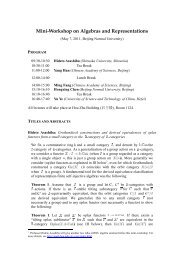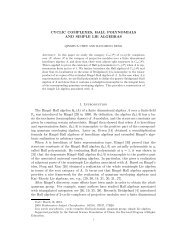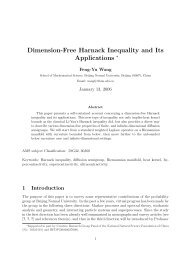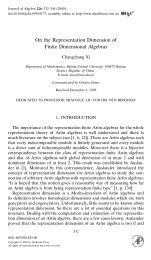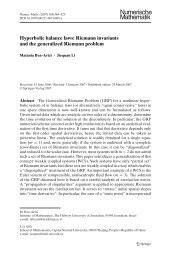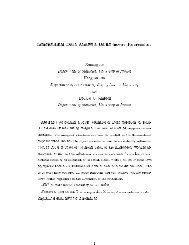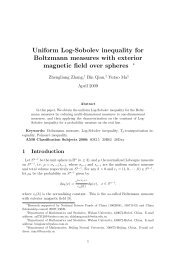Fourier Spectral Moving Mesh Method for Willmore Equation of ...
Fourier Spectral Moving Mesh Method for Willmore Equation of ...
Fourier Spectral Moving Mesh Method for Willmore Equation of ...
Create successful ePaper yourself
Turn your PDF publications into a flip-book with our unique Google optimized e-Paper software.
where g(⃗x) = 1 e − x2 1 +x2 22πσ 2 2σ 2is the Gauss kernel.5.2 The choice <strong>of</strong> some parametersAs to the parameter β, which is used to in the monitor function ω = √ 1 + β 2 u 2 x, β can beused to control the concentration <strong>of</strong> mesh grid points effectively. In our simulation work, thegrids points are more concentrated when β is bigger(β = 10), however, we do find that undersuch circumstance, the mesh grid points might concentrate in the areas where the solutionis not steep. And such concentration might be caused by the effect <strong>of</strong> mesh grid points inother areas with large gradient . And when we use a small value e.g. β 2 = 0.1, the meshgrid points have less de<strong>for</strong>mation in irrelevant areas, while still concentrate effective on areawhere u is steep.The parameter τ which is used to control the evolution <strong>of</strong> the mesh, it is set to be thesame as the real time t.And we simply treat σ ∗ = 0 in our simulation.5.3 The constrainsOne primary requirement in our simulation is to guarantee that the final numerical solutionsare the minimizers <strong>of</strong> above energy, under the two constraints. During our simulation, whenthe energy doesn’t decay, we halve the time step δt and δτ, and the the energy will keepdecaying. And when the energy doesn’t change significantly, we stop our program.Since our variation space is taken as H −1 , the equation is <strong>of</strong> conservative <strong>for</strong>m, hence wedon’t have to treat the volume constrains on purpose, and our numerical results shows thatthe volume is almost preserved as a constant.As to the area constrains, at first we neglect such constrains, and after a few time steps,we obtain a smooth solution, and we dynamically control the penalty constant M 2 and thedesired area β, while doing such adjustment, we neglect the decay <strong>of</strong> the energy. And wethe area is maintained, we then adjust the time step to guarantee the decay <strong>of</strong> the energy.9




